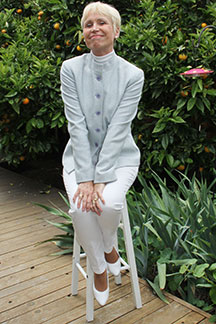Else Ury, author of the famous Nesthaekchen series, http://www.walled-in-berlin.com/j-elke-ertle/nesthaekchen-popular-childrens-books/ was the daughter of a prosperous Jewish tobacco merchant and grew up in a bourgeois household during the German Empire. The family lived in an upper-class neighborhood in the Kantstrasse in Charlottenburg, just around the corner from where I grew up. Although, by the time my family rented one of those flats, they had long been divided into three or four small working-class apartments. In many ways, the Nesthaekchen series echoes Ms. Ury’s life in the Kantstrasse, where she penned the books. Despite having attended a prestigious high school, she did not pursue higher education because it wasn’t customary then for women to go after advanced degrees. Else Ury never married, became a tremendously successful writer of children’s books and lived with her parents until their deaths.
Else Ury during the Nazi years
When the Nazi party came into power, Else Ury’s writing career came to a sudden end. In 1935, she was barred from the Reichsschrifttumskammer (Reich Literature Chamber) and forced to cease publishing because she could not prove Aryan heritage. Other members of her family had already been barred from practicing their professions. By 1939, Else Ury’s life in Germany had become untenable. Stripped of their possessions, Else and her mother were forced to leave their beautiful home and relocate to a Judenhaus (a ghetto house where Jews were awaiting deportation). Her mother passed away one year later. In 1943, Else Ury was deported to Auschwitz and gassed the day she arrived.
Else Ury and her most troublesome Nesthaekchen volume
During Else Ury’s lifetime, Nesthaekchen und der Weltkrieg (Nesthaekchen and the World War), the fourth volume of the series, was the most popular. The book refers to World War I. Following World War II, the Allied Control Board, in charge of determining which books were suitable for publishing, viewed her narratives as glorifications for Germany’s role in World War I and placed the book on the censorship list. The publisher subsequently pulled the volume from circulation, and it wasn’t reworked and republished for many years.
Else Ury Remembered
Until 1992, the general public knew little of Else Ury’s fate. That changed abruptly when Marianne Brentzel, another German author, reconstructed Ms. Ury’s life through photographs and letters. The work bore the shocking title, Nesthaekchen kommt ins KZ (Nesthaekchen is sent to the concentration camp). https://www.welt.de/geschichte/zweiter-weltkrieg/article112708668/Als-Deutsche-Nesthaekchens-Mutter-ermordeten.html In 2007, Brentzel published a biography of Else Ury entitled, Mir kann doch nichts geschehen (Nothing can happen to me). Now, the public became keenly aware of the fate of its once favorite author. Since then, a memorial plaque has been affixed to the façade of the apartment building in Kantstrasse 30 where Else Ury penned the series. In 1998, a shopping arcade was dedicated to her. The colonnade is located beneath the Stadtbahn – Berlin’s elevated train – between Bleibtreustrasse and Knesebeckstrasse, close to where Ury was raised. A Stolperstein (stumpling stone) http://www.walled-in-berlin.com/j-elke-ertle/berlins-stolpersteine/ was installed in front of the former “Judenhaus,” in Solingerstrasse 10 to which Ury and her mother had been relocated in 1939. And the well-known memorial and educational site, Haus der Wannsee Konferenz, http://www.walled-in-berlin.com/j-elke-ertle/berlins-house-wannsee-conference/ hosted an exhibition that featured the life of Else Ury and included the suitcase she took to Auschwitz.

Memorial plaque affixed to the facade of Kantstrasse 30 in Berlin, where Else Ury penned Nesthaekchen. Photo © J. Elke Ertle, 2017. www.walled-in-berlin.com
My recollections of the Nesthaekchen Series
I never knew that Else Ury was Jewish or that she had been gassed in Auschwitz until my eye fell on the memorial plaque on a visit to Berlin. That was in 2017. The Nesthaekchen books were my all-time favorite reading during my early teens. What made the series so special to me was the fact that Nesthaekchen’s childhood played out in my own neighborhood. I fully expected to see her walk down my street one day. Although I wasn’t born until after World War II and did not grow up among the privileged, I completely identified with Annemarie Braun and envisioned my life to play out exactly like hers when I grew up. To my delight I learned that reprints of the series are still available.
For a sneak peek at the first 20+ pages of my memoir, Walled-In: A West Berlin Girl’s Journey to Freedom, click “Download a free excerpt” on my home page and feel free to follow my blog about anything German: historic and current events, people, places and food.
Walled-In is my story of growing up in Berlin during the Cold War. Juxtaposing the events that engulfed Berlin during the Berlin Blockade, the Berlin Airlift, the Berlin Wall and Kennedy’s Berlin visit with the struggle against my equally insurmountable parental walls, Walled-In is about freedom vs. conformity, conflict vs. harmony, domination vs. submission, loyalty vs. betrayal.

















